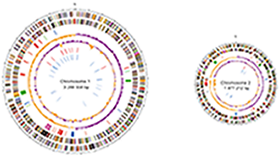
Figure 1. Whole genome sequence of
Vibrio parahaemolyticus

Figure 2. Characterization and comparison of the genomes of pathogenic bacteria by using DNA microarrays
This research group is studying pathogenic bacteria from the genomic point of view.
Our main research targets are as follows:
1. Characterization of the mechanism(s) used by bacterial pathogens to infect host organisms by identifying infection-related changes in pathogen genome expression: To understand the molecular mechanisms by which bacterial pathogens infect host organisms, we are using DNA microarrays and other molecular methods to investigate the changes in the genome expression pattern of various bacterial pathogens that occur during their interaction with their target host.
2. Analysis of the mechanism(s) that lead to the emergence of new infectious diseases: The unique features of various newly emerged bacterial pathogens are being studied by analyzing their genomes and comparing them with those of other bacterial strains.
3. Investigation of the life cycles of bacterial pathogens in their natural environments: Based on what is currently understood about various bacterial pathogens, we are seeking to characterize their life cycles in their natural habitats.
4. Development of new methods for the rapid identification of bacterial pathogens based on genomic information: To rapidly diagnose bacterial infections, a novel system for identifying bacterial pathogens by high-throughput DNA sequencing is being developed.